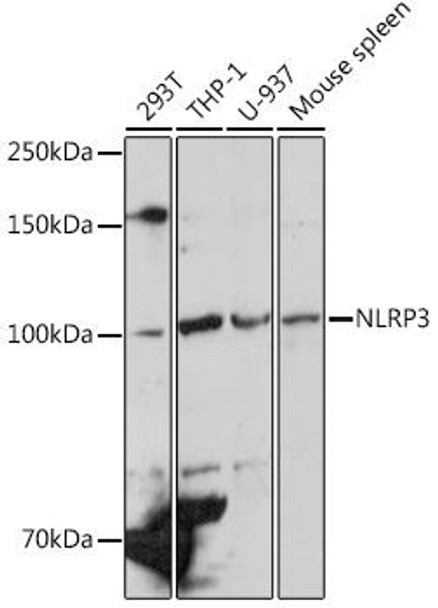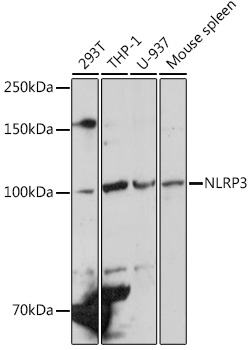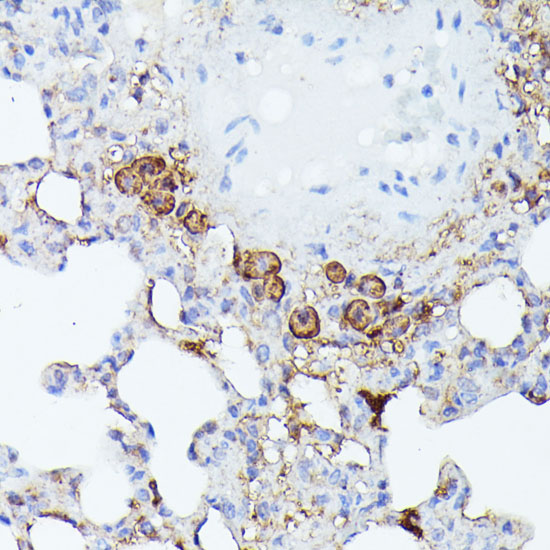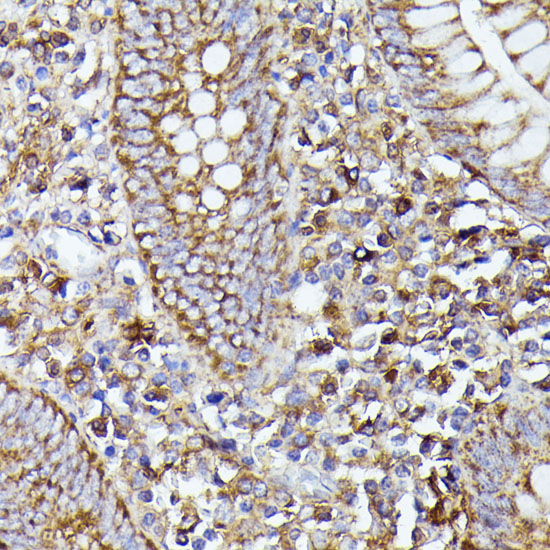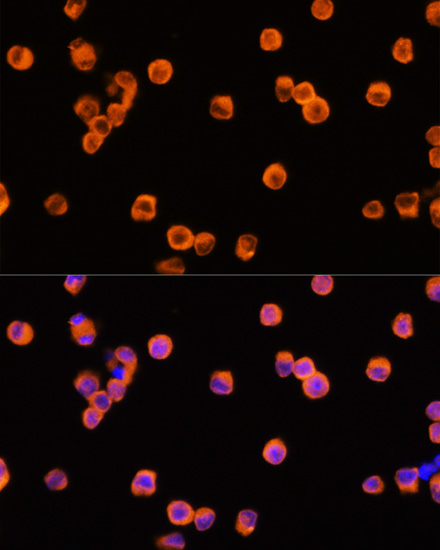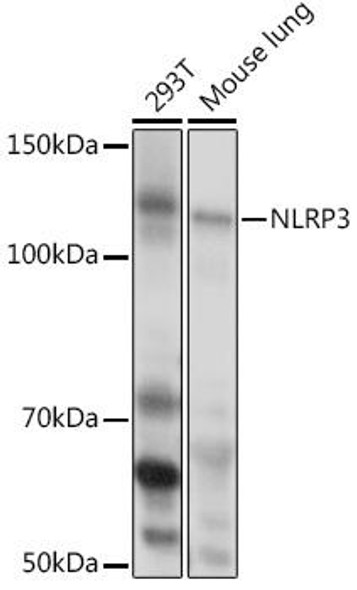Anti-NLRP3 Antibody (CAB12694)
- SKU:
- CAB12694
- Product type:
- Antibody
- Reactivity:
- Human
- Mouse
- Rat
- Host Species:
- Rabbit
- Isotype:
- IgG
- Antibody Type:
- Polyclonal Antibody
- Research Area:
- Immunology
Description
| Antibody Name: | Anti-NLRP3 Antibody |
| Antibody SKU: | CAB12694 |
| Antibody Size: | 20uL, 50uL, 100uL |
| Application: | WB IHC IF |
| Reactivity: | Human, Mouse, Rat |
| Host Species: | Rabbit |
| Immunogen: | A synthetic peptide corresponding to a sequence within amino acids 900 to the C-terminus of human NLRP3 (NP_001120934.1). |
| Application: | WB IHC IF |
| Recommended Dilution: | WB 1:1000 - 1:3000 IHC 1:50 - 1:200 IF 1:50 - 1:200 |
| Reactivity: | Human, Mouse, Rat |
| Positive Samples: | 293T, THP-1, U-937, Mouse spleen |
| Immunogen: | A synthetic peptide corresponding to a sequence within amino acids 900 to the C-terminus of human NLRP3 (NP_001120934.1). |
| Purification Method: | Affinity purification |
| Storage Buffer: | Store at -20°C. Avoid freeze / thaw cycles. Buffer: PBS with 0.02% sodium azide, 50% glycerol, pH7.3. |
| Isotype: | IgG |
| Sequence: | CCWD LSTL LTSS QSLR KLSL GNND LGDL GVMM FCEV LKQQ SCLL QNLG LSEM YFNY ETKS ALET LQEE KPEL TVVF EPSW |
| Gene ID: | 114548 |
| Uniprot: | Q96P20 |
| Cellular Location: | Cytoplasm, Endoplasmic reticulum, Inflammasome, Nucleus, Secreted, cytosol |
| Calculated MW: | 83kDa/105kDa/111kDa/112kDa/115kDa/118kDa |
| Observed MW: | 100KDa |
| Synonyms: | NLRP3, AGTAVPRL, AII, AVP, C1orf7, CIAS1, CLR1.1, FCAS, FCAS1, FCU, MWS, NALP3, PYPAF1 |
| Background: | This gene encodes a pyrin-like protein containing a pyrin domain, a nucleotide-binding site (NBS) domain, and a leucine-rich repeat (LRR) motif. This protein interacts with the apoptosis-associated speck-like protein PYCARD/ASC, which contains a caspase recruitment domain, and is a member of the NALP3 inflammasome complex. This complex functions as an upstream activator of NF-kappaB signaling, and it plays a role in the regulation of inflammation, the immune response, and apoptosis. Mutations in this gene are associated with familial cold autoinflammatory syndrome (FCAS), Muckle-Wells syndrome (MWS), chronic infantile neurological cutaneous and articular (CINCA) syndrome, and neonatal-onset multisystem inflammatory disease (NOMID). Multiple alternatively spliced transcript variants encoding distinct isoforms have been identified for this gene. Alternative 5' UTR structures are suggested by available data; however, insufficient evidence is available to determine if all of the represented 5' UTR splice patterns are biologically valid. |
| UniProt Protein Function: | NLRP3: May function as an inducer of apoptosis. Interacts selectively with ASC and this complex may function as an upstream activator of NF-kappa-B signaling. Inhibits TNF-alpha induced activation and nuclear translocation of RELA/NF-KB p65. Also inhibits transcriptional activity of RELA. Activates caspase-1 in response to a number of triggers including bacterial or viral infection which leads to processing and release of IL1B and IL18. Defects in NLRP3 are the cause of familial cold autoinflammatory syndrome type 1 (FCAS1); also known as familial cold urticaria. FCAS are rare autosomal dominant systemic inflammatory diseases characterized by episodes of rash, arthralgia, fever and conjunctivitis after generalized exposure to cold. Defects in NLRP3 are a cause of Muckle-Wells syndrome (MWS); also known as urticaria-deafness-amyloidosis syndrome. MWS is a hereditary periodic fever syndrome characterized by fever, chronic recurrent urticaria, arthralgias, progressive sensorineural deafness, and reactive renal amyloidosis. The disease may be severe if generalized amyloidosis occurs. Defects in NLRP3 are the cause of chronic infantile neurologic cutaneous and articular syndrome (CINCA); also known as neonatal onset multisystem inflammatory disease (NOMID). CINCA is a rare congenital inflammatory disorder characterized by a triad of neonatal onset of cutaneous symptoms, chronic meningitis and joint manifestations with recurrent fever and inflammation. Belongs to the NLRP family. 5 isoforms of the human protein are produced by alternative splicing. |
| UniProt Protein Details: | Protein type:Inhibitor Chromosomal Location of Human Ortholog: 1q44 Cellular Component: cytoplasm; cytosol Molecular Function:peptidoglycan binding; protein binding; ATP binding Biological Process: caspase activation; apoptosis; negative regulation of acute inflammatory response; positive regulation of caspase activity; interleukin-1 beta production; defense response; negative regulation of NF-kappaB import into nucleus; positive regulation of interleukin-1 beta secretion; signal transduction; protein oligomerization; activation of NF-kappaB transcription factor; negative regulation of interleukin-1 beta secretion; inhibition of NF-kappaB transcription factor; negative regulation of inflammatory response; interleukin-18 production; innate immune response; interleukin-1 secretion; inflammatory response; detection of biotic stimulus; defense response to virus Disease: Cinca Syndrome; Familial Cold Autoinflammatory Syndrome 1; Muckle-wells Syndrome |
| NCBI Summary: | This gene encodes a pyrin-like protein containing a pyrin domain, a nucleotide-binding site (NBS) domain, and a leucine-rich repeat (LRR) motif. This protein interacts with the apoptosis-associated speck-like protein PYCARD/ASC, which contains a caspase recruitment domain, and is a member of the NALP3 inflammasome complex. This complex functions as an upstream activator of NF-kappaB signaling, and it plays a role in the regulation of inflammation, the immune response, and apoptosis. Mutations in this gene are associated with familial cold autoinflammatory syndrome (FCAS), Muckle-Wells syndrome (MWS), chronic infantile neurological cutaneous and articular (CINCA) syndrome, and neonatal-onset multisystem inflammatory disease (NOMID). Multiple alternatively spliced transcript variants encoding distinct isoforms have been identified for this gene. Alternative 5' UTR structures are suggested by available data; however, insufficient evidence is available to determine if all of the represented 5' UTR splice patterns are biologically valid. [provided by RefSeq, Oct 2008] |
| UniProt Code: | Q96P20 |
| NCBI GenInfo Identifier: | 262527566 |
| NCBI Gene ID: | 114548 |
| NCBI Accession: | Q96P20.3 |
| UniProt Secondary Accession: | Q96P20,O75434, Q17RS2, Q59H68, Q5JQS8, Q5JQS9, Q6TG35 Q8TCW0, B2RC97, B7ZKS9, B7ZKT2, B7ZKT3, |
| UniProt Related Accession: | Q96P20 |
| Molecular Weight: | |
| NCBI Full Name: | NACHT, LRR and PYD domains-containing protein 3 |
| NCBI Synonym Full Names: | NLR family, pyrin domain containing 3 |
| NCBI Official Symbol: | NLRP3 |
| NCBI Official Synonym Symbols: | AII; AVP; FCU; MWS; FCAS; CIAS1; NALP3; C1orf7; CLR1.1; PYPAF1; AGTAVPRL |
| NCBI Protein Information: | NACHT, LRR and PYD domains-containing protein 3; cryopyrin; caterpiller protein 1.1; PYRIN-containing APAF1-like protein 1; NACHT, LRR and PYD containing protein 3; cold autoinflammatory syndrome 1 protein; NACHT domain-, leucine-rich repeat-, and PYD-containing protein 3; nucleotide-binding oligomerization domain, leucine rich repeat and pyrin domain containing 3 |
| UniProt Protein Name: | NACHT, LRR and PYD domains-containing protein 3 |
| UniProt Synonym Protein Names: | Angiotensin/vasopressin receptor AII/AVP-like; Caterpiller protein 1.1; CLR1.1; Cold autoinflammatory syndrome 1 protein; Cryopyrin; PYRIN-containing APAF1-like protein 1 |
| Protein Family: | NACHT, LRR and PYD domains-containing protein |
| UniProt Gene Name: | NLRP3 |
| UniProt Entry Name: | NALP3_HUMAN |

